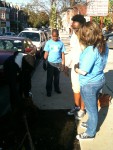This slideshow requires JavaScript.
Parkview Riparian Buffer Planting
Please come and help plant a riparian buffer in Cheltenham Township! No experience is needed! We will teach you how to plant the trees and shrubs. All of the plants are “volunteer friendly” ‐‐ so young, old and anyone in‐between can plant. Bring: Gloves, shovel and a friend!
DATE: Saturday, November 5, 2011
TIME: 9:00 a.m. to 4:00 p.m.
PLACE: Meet at Parkview Park at the corner of Parkview Road and Front Street in Cheltenham
When we saw this flyer, we knew we must come!
Bianca: Resident gardening expert.
Anna: Camerawoman.
Shirley: Navigator.
Layla: Root loosening expert.
A little about our adventure this week will be written by me, Anna.
November 5th planting event started with a beautiful chilly autumn morning. Each of our group members Shirley, Layla, Bianca and I arrived separately to the designated area. We found a large amount of potted trees and a forest of shovels under beautiful golden surroundings. Everything was ready and organized for the tree planting. Many holes where dug on the ground, where they would like us to plant the trees. I was very surprised to see this, and wondered when the organizers of the event had time to do this. It was a quite morning at first, but the volunteer’s voices, as how they gathered for the tree planting where filled with excitement and energy.
The tree planting started with a quick demonstration, and instructions of how to plant a tree. The instructor told us to make sure that the tree is sitting straight at a 90 degree angle despite the slope of the ground. She planted the tree with speed, despite, the hill at which the tree was being planted.
After that, we got to work! Shirley was very hyper, and her eyes where full of excitement while she ran back and forth and around the tree. Where did she get all of that energy? It was good to be surrounded by such a positive atmosphere. We were told to divide into pairs. At first it was Shirley and I working together, but a minute later Layla and Bianca joined us shortly. We worked together at first to get the hand of this new skill. Then we divided into pairs, and once in a while switched our partners. First we planted at the area which had a slant near the tree of the instructor. We worked down, and the area became a flat land where it was easier to work. We always worked near each other, and it was quite fun!
The only group member that planted trees this year was Layla. Bianca does a lot of planting in her own garden at home, so Shirley and I found ourselves asking for advice from the more experienced group members. Since the trees where pot grown, we had to make sure to loosen the roots before planting in order to prevent them gurgling later in their life. Layla was an expert at this, and showed us various techniques. The first 8 trees seemed to be planted very quickly to my surprise.
There was a nice variety of trees which was available for planting. At some point we weren’t just planting trees, but playing guessing games as we approached the young potted trees .“I think this is a red bud” I told to Bianca, and Bianca smiled saying “No no, but good guess this is a Mulberry”. The little shrub had no leaves, and the only way to tell was to look at its little trunk. We planted the Willows near the small creek, and Bianca approved saying willows will be comfortable here near the water. I imagined the trees reaching maturity and how romantic this place could be. I couldn’t wait to come back and see these little shrubs to grow into magnificent trees!
We planted Eastern Redbud, Dogwood, Swamp White oak, Mulberry, Black Willow, Scarlet Oak, Persimmon, Yellow Birch, Ironwood, Pin Oak, and even Red maple!
We were so happy when we saw our favorite redbuds and dogwood. They always spruce up the landscape. The Red maple, a fast grower, the oaks would be slow growers, but are good trees for our region. The verity would look nice in spring and fall colors.
having fun while planting

We worked in several locations. We started on the corner and worked our way down to the creek, and then we crossed the road and planted a bunch of trees on the corner. After that we moved on along the road, where there was quite a lot of space. Later seeds where provided to plant wild grasses. We had more trees then wholes, so we also experienced the pleasure of digging. The soil varied from location to location. The first place had a very soft soil, which had a nice mixture of clay and soil. The location along the road was very rocky, as if we are in the mountains! It was a bit frustrating to dig up many rocks after a while.

another huge rock dug up!( As you can see we got very frustrated )

This little friendly poison ivy waited for us near one of the pits
We were quite tired at the end, but our spirits were up. It felt really nice to be in fresh air, playing with dirt among gorgeous trees. I was so happy to learn this new skill. There is such a difference between knowing theoretically how to do something, and actually experiencing it. When you live in a city you can feel out of touch with nature, and even with your community. Planting at least one tree in your life is something I would recommend to anyone.
As I plant this tree,
I think how it will be.
How it will grow and change,
How different will I be?
As I touch it, will it still remember me?

Some of the trees planted




















































